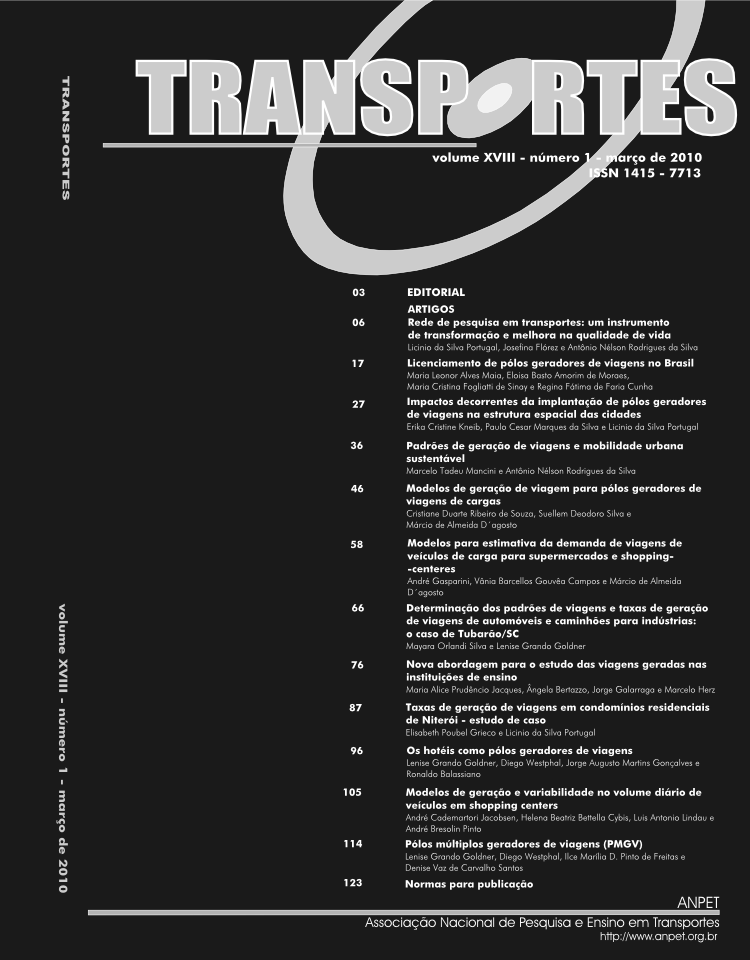Modelos de geração e variabilidade no volume diário de veículos em shopping centers
DOI:
https://doi.org/10.14295/transportes.v18i1.388Abstract
Resumo: Os modelos de geração de viagens, utilizados nos Estudos de Impacto de Tráfego (EIT) de shopping centers, geralmente estimam volumes diários médios anuais de veículos atraídos. Neste artigo são confrontados os volumes estimados por modelos referenciados na literatura com volumes veiculares observados em seis empreendimentos localizados na região metropolitana de Porto Alegre. Quando comparadas com as distribuições de volumes diários de cada shopping center, as estimativas revelam erros expressivos. Modelos baseados apenas na Área Bruta Locável (ABL) mostram-se incapazes de representar as diferenças entre os empreendimentos, indicando a necessidade da incorporação de novas variáveis explicativas. Entende-se que as diferenças entre estimativas e valores observados estejam fortemente associadas ao poder aquisitivo dos clientes. O artigo propõe modelos não-convencionais de geração de viagens construídos com os dados dos shopping centers estudados. Entre os modelos estimados, o que incorpora a variável "valor do aluguel" das lojas dos empreendimentos resultou nos menores erros de estimativa.
Abstract: Trip generation models, applied in Traffic Impact Studies of shopping centers, usually estimate annual average daily volumes of attracted private vehicles. In this paper we confront volumes estimated by models referred in the literature with observed vehicular volumes of six shopping centers located within the Metropolitan Area of Porto Alegre, Brazil. When compared to the distributions of daily volumes of each shopping center, estimates reveal expressive errors. Models based only on gross leasing areas are unable to represent the differences between the shopping centers, suggesting the need to incorporate new explanatory variables. We understand that the differences between estimated and observed values are strongly associated to the income of the clients. The paper presents non-conventional trip generation models estimated with data from the shopping centers analyzed. Amongst the estimated models, the one that incorporates the variable "rental prices" of the shops resulted in the smaller estimation errors.
Downloads
Downloads
Published
How to Cite
Issue
Section
License
Authors who submit papers for publication by TRANSPORTES agree to the following terms:
- The authors retain the copyright and grant Transportes the right of first publication of the manuscript, without any financial charge, and waive any other remuneration for its publication by ANPET.
- Upon publication by Transportes, the manuscript is automatically licensed under the Creative Commons License CC BY 4.0 license. This license permits the work to be shared with proper attribution to the authors and its original publication in this journal.
- Authors are authorized to enter into additional separate contracts for the non-exclusive distribution of the version of the manuscript published in this journal (e.g., publishing in an institutional repository or as a book chapter), with recognition of the initial publication in this journal, provided that such a contract does not imply an endorsement of the content of the manuscript or the new medium by ANPET.
- Authors are permitted and encouraged to publish and distribute their work online (e.g., in institutional repositories or on their personal websites) after the editorial process is complete. As Transportes provides open access to all published issues, authors are encouraged to use links to the DOI of their article in these cases.
- Authors confirm they have obtained all required employer permissions for the publication and CC BY 4.0 licensing of the manuscript, particularly if the employer holds any claim to the manuscript's copyright. Authors assume all responsibility for employer-related copyright issues, releasing ANPET and Transportes from any related liability.
- Authors assume full responsibility for the content of the manuscript, including the necessary and appropriate authorizations for the disclosure of collected data and obtained results, releasing ANPET and Transportes from any responsibility in this regard.
Last update: 11/27/2025











